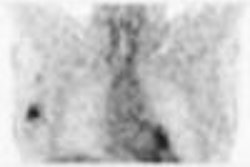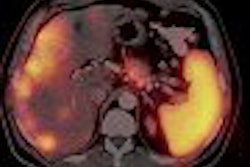
The prospect of scanning a pediatric patient can create fear and self-doubt in even the most experienced technologist. Yet most techs will encounter children as patients at some time and with some frequency. Keeping the following tips in mind can help achieve a good quality scan and a happy patient.
Preparation: Laying the foundation for success
The best time to begin preparation is as soon as the patient is scheduled. Probably the first issue to be addressed is the dose of radiopharmaceutical to be used. Pediatric nuclear medicine literature can offer many algorithms for dose calculation; a nearby children's hospital will often share this knowledge as well. An important consideration is the concept of minimum dose: despite the small size of a patient, generally doses of less than 20% of the adult dose do not yield sufficient counting statistics for good images.
Next, discuss the scan and patient condition with the radiologist. Occasionally a pediatrician will order a particular scan, but upon review it is determined that a different scan or even imaging modality is more suitable for that patient. Finding this out sooner rather than later is smart for the family and demonstrates thoroughness to the referring physician.
Once the decision is made to proceed with the scan, the technologist should contact the family. After an introduction and explanation of the procedure, including patient prep and estimated time spent for the appointment, it is highly recommended that an attempt should be made to inquire about the pediatric patient: Have there been past medical visits that terrified the child? Does the child have a favorite toy or video? Questions like these give the technologist valuable insight into the patient so that the environment may be tailored to the child. Also, a large part of this initial discussion is to invite the parents to be an active participant in the scanning process.
Regardless of how minor the child's condition may be, parents often have much anxiety over the potential diagnosis and how terrifying the exam may be for their child. Providing them information about the procedure arms them so that they can answer their child's questions truthfully. Giving the family a number to call for further questions will also allay anxiety and keep the communication open between imagers and the patient's family.
Imaging: What is the objective?
A successful scan on a child requires planning in regard to imaging. Many times children have a much shorter attention span or window of cooperation than adults. Matching the most important views with a willing patient gives the most useful information to the radiologist.
An example is a radionuclide bone scan ordered on a 5-year-old with low back pain. The nuclear medicine technologist and radiologist should discuss which images are most important: perhaps SPECT and spot imaging of the lumbosacral spine is paramount.
Ideally, particularly in children, images of the whole body should be obtained. But if the patient's limited cooperation only allows for a SPECT and some spot images, the radiologist is apt to be able to answer the clinical question with this abbreviated scan. If the radiologist requires the entire body to be scanned, starting with the feet first and work up to the head is often advised. Children can be initially frightened by a gamma camera close to their chest or face; starting with the lower extremities demonstrates the painlessness of the procedure and promotes trust in the technologist.
Sedation: Yes or no?
While a technologist may be tempted to require sedation for all pediatric patients, simple ways can determine whether the patient or procedure warrant it. Sedation is expensive and not without risk, so using it prudently is the hallmark of a savvy department.
Obviously, sedation is used to immobilize a patient who is apt to move either out of fear or young age. Yet immobilization can be achieved by means other than pharmacologic. Many types of patient immobilizers or "papoose boards" are on the market. They are ideal for procedures on children under the age of 5 when some movement can be tolerated, such as in a diuretic renogram or gastric emptying scan.
These procedures rely on time-activity curves generated by regions of interest over organs. Even cooperative adults move to some extent over 30 to 60 minutes of scan time; a well-wrapped toddler is no different. Distraction goes hand in hand with immobilization: toys, blowing bubbles, listening to a story, and watching videos are all ways that parents and medical personnel can distract a child from the procedure and toward a more enjoyable activity.
With high-resolution scans requiring significant patient cooperation, physical immobilization is not enough. Roughly speaking, patients under the age of 3 or 3½ aren't able to hold still for a whole-body bone scan or SPECT procedure. Decisions regarding sedation are easy in some cases: an 11-month-old needing a bone scan to stage for neuroblastoma absolutely requires sedation for good quality images of the entire skeleton; a 5-year-old with Kawasaki's disease can probably hold still for a SPECT myocardial perfusion study as long as the parents and an engaging video are nearby.
But what about a seemingly mild mannered 3-year-old that needs a bone scan to rule out juvenile rheumatoid arthritis? The safest and surest approach is to set up the bone scan with sedation but attempt to perform the procedure "awake." For example, if the child's bone scan is to begin at noon with sedation, the technologist can begin imaging at 11:30. The child's favorite video can be playing, and the soothing technologist can begin imaging at the feet. If the child is indeed cooperative and a complete set of images are acquired, then the sedation request can be canceled.
But if the child is unable to cooperate for some of or for the entire scan, sedation is performed and the appropriate images acquired. Either with or without sedation, the scan is performed and the family is impressed by the skill and consideration of the staff.
During the scan: Distract, communicate, and encourage
If the above mentioned steps have been taken, the actual scan should be relatively easy. All dosing and image acquisition information will have already been decided. Ideally, the same technologist who spoke by phone to the parent should be the tech who greets the family. Familiarity with the patient will provide the continuity that puts a parent at ease.
If the tech on the phone is unavailable, then introducing oneself as a coworker can establish rapport. If the child is open to conversation, then communication between the technologist and the pediatric patient can begin immediately. Rapport can be made quickly once a common interest is found: vacation plans, pets, home town, sports, current movies or video games, or holiday activities. But a shy child should not be coerced into talking with the tech.
When bringing young patients into the scan room, it can be helpful to have a favorite movie already playing so as to immediately grab their attention. Alternatively, the child and parent can choose from some videos or other games. When given some choice over their care or surroundings, children are usually more willing to cooperate than when all choice is given to adults.
It is this author's experience that parents should accompany the patient during all phases of imaging. They can soothe the child during venipuncture, and help to distract and encourage during image acquisition. The aim is for the tech to truly partner with the family to achieve a good quality scan and a positive experience for the child.
Parents who understand and assist in scanning are more effective at persuading their children to relax than parents who are prohibited from the scanning area. Parents themselves sometimes express anxiety over venipuncture or with claustrophobia; the best tack is for the technologist to acknowledge the fear but ask that they refrain from sharing that feeling with the patient. The child and family should be updated frequently as to the status of the exam; encouragement and positive feedback are almost impossible to overdo!
After the scan: Reward, rejoice, and remember
While the radiologist is reviewing the images, the parent and child can relax. Depending on circumstances, this time can be spent in the waiting room or the imaging area. This can be a time to follow through on promises: the child can pick a toy from a basket, draw a picture, use the restroom, or sit with the technologist at the image processing station to look at a scan (generic and nonlabeled).
Once the child is free to leave, both the patient and family should be thanked profusely. Parents can be praised for their assistance in achieving a challenging but important scan or for their ideas in distracting the child. If the procedure has been difficult for the child, this can be acknowledged by saying, "I know that was tough for you, but you were very brave."
If the technologist has been kind and compassionate and has made a sincere attempt to bond, that is what the family is likely to remember. Even children who cry during an entire exam will oftentimes say goodbye with a hug and a smile to a kindly technologist. The goal is for the family and patient to leave the experience with an essentially positive attitude. The child's memory of a medical event should be full of fun and compassion; the parents will have a sense of empowerment over their choice of healthcare provider. The technologist can rejoice about a job well done.
By Sandy Ferency
AuntMinnie.com contributing writer
October 20, 2006
Sandy Ferency is a nuclear medicine technologist who trained at William Beaumont Hospital in Royal Oak, MI, and has 25 years of experience in staff and supervisory positions. She is currently employed by brain SPECT imaging provider Brain Matters of Denver.
Related Reading
PET imaging improves accuracy of childhood Hodgkin's disease staging, September 26, 2006
Part IV: Imaging the pediatric patient: CT applications in pediatric imaging, May 12, 2004
Part III: Imaging the pediatric patient: the use of CT in pediatric imaging, May 7, 2004
Part II: Imaging the pediatric patient: diagnostic radiography, April 26, 2004
Part I: Imaging the pediatric patient: beyond the smiles and stickers, April 22, 2004
Copyright © 2006 Sandy Ferency




















